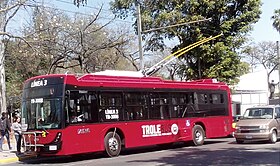| Guadalajara trolleybus system | |
|---|---|
 A Guadalajara DINA trolleybus in 2016 | |
| Operation | |
| Locale | Guadalajara, Jalisco, Mexico |
| Open | 15 December 1976 |
| Status | Open |
| Routes | 1 |
| Owner(s) |
|
| Operator(s) | SITEUR |
| Infrastructure | |
| Electrification | 600 V DC |
| Statistics | |
| 2017 | 3.7 million[1] |
| Website | http://www.siteur.gob.mx/sitren/caracteristicas.html SITEUR (in Spanish) |
The Guadalajara trolleybus system (Spanish: Sistema de trolebuses de Guadalajara) serves Guadalajara, the capital city of the state of Jalisco in Mexico.
Opened on 15 December 1976,[2] the system is owned by the government of Jalisco. From its opening until January 2016, it was operated by Sistema de Transporte Colectivo de la Zona Metropolitana (Sistecozome), an agency of the Jalisco government. On 29 January 2016, operation was transferred from Sistecozome to another state agency, Sistema de Tren Eléctrico Urbano (SITEUR), which also operates the Guadalajara light rail system.[3][4] A particularly notable feature of the system was its use, from the system's opening in late 1976 until circa 1 March 1988, of a trolleybus-only subway, with multiple stations, under Avenida Federalismo in the central part of the city.[5]: 88 The subway was closed in 1988 so that it could be converted for use by light rail.[5]
A new fleet of 25 DINA/Škoda trolleybuses was purchased in 2015, and they began to enter service on 2 February 2016, when the system reopened – now under its new operator – after a one-year suspension[4] that had begun on 31 January 2015.[6] Previously, the fleet had consisted of MASA trolleybuses, from 1982 until 2015, and originally ex-Chicago Marmon-Herrington trolleybuses, which had been in use from 1976 to 1993.

At the time of its reopening in February 2016 and introduction of the new operator and new fleet, the system had only one route, designated "Line 3" of SITEUR's "Sitren" bus network, an east–west route that was numbered 400 under Sistecozome.[4][7][8] In January 2016, it was reported that officials planned also to transfer Sistecozome route 500, which has been operated by diesel buses since January 2015, to SITEUR and reinstate trolleybus operation to it, as Sitren Line 4,[3][4] but by 2019 this had never occurred.[1]
- ^ a b "Trolleynews [regular news section]". Trolleybus Magazine. No. 344. UK: National Trolleybus Association. March–April 2019. p. 70. ISSN 0266-7452.
- ^ Morgan, Steve (September–October 1990). "Mexico Review, Part 1: Guadalajara". Trolleybus Magazine. No. 173. UK: National Trolleybus Association. pp. 104–115. ISSN 0266-7452.
- ^ a b "Los trolebuses pasan de Sistecozome a Siteur" [Trolleybuses pass from Sistecozome to Siteur]. El Informador (in Spanish). 31 January 2016. Archived from the original on 1 February 2016. Retrieved 8 June 2017.
- ^ a b c d Trolleybus Magazine No. 327 (May–June 2016), p. 92. National Trolleybus Association (UK). ISSN 0266-7452.
- ^ a b Aberson, Gert (July–August 1993). "Guadalajara Update". Trolleybus Magazine. No. 190. UK: National Trolleybus Association. pp. 87–92. ISSN 0266-7452.
- ^ Trolleybus Magazine No. 320 (March–April 2015), p. 58.
- ^ "La ruta 400 de trolebús ya opera como línea 3 de Sitren" [Trolleybus route 400 now operates as Sitren Line 3]. Milenio (in Spanish). 2 February 2016. Retrieved 8 June 2017.
- ^ "Hoy arrancan nuevos trolebuses; poseen tecnología de vanguardia" [New trolleybuses start today; They have cutting-edge technology]. El Informador (in Spanish). 2 February 2016. p. 1-A. Archived from the original on 3 February 2016. Retrieved 8 June 2017.
